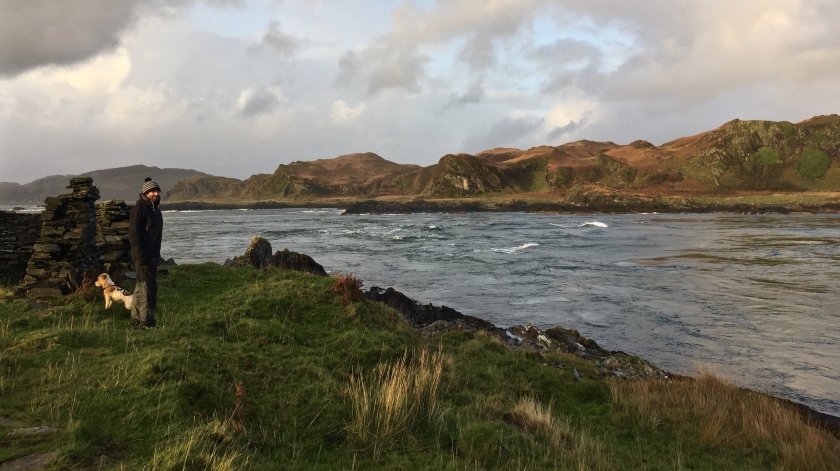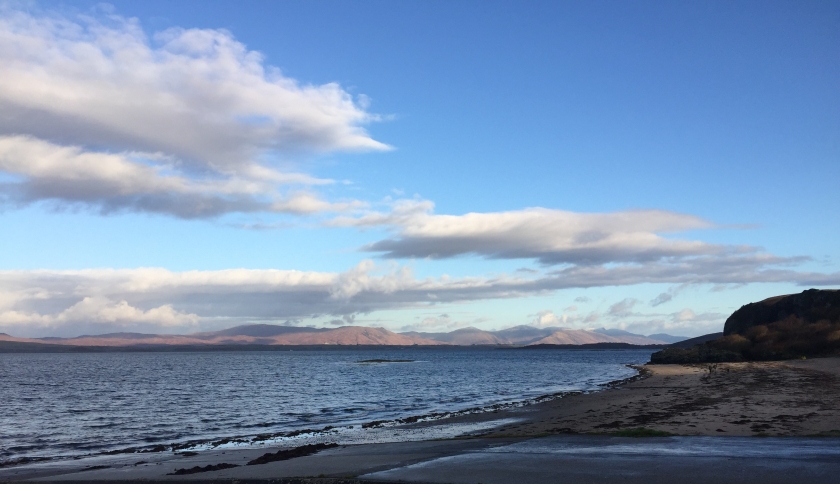We’re at the North Cuan ferry port, waiting to make the crossing to the isle of Luing. The wind is blowing and the dark blue Atlantic swirls and bubbles, but there’s no chance of getting sea sick: the channel of water we’re about to cross is so narrow that we can see the ferryman chatting to locals on the far side. If it were calmer, we could get the kayaks off the roof rack and paddle there. Only we’re laden with shopping – seven days’ worth of food and drink – to save us having to make the 19-mile trip to the nearest supermarket during our first week of island life – and leave more time for exploring.

Luing is part of the Hebrides – famed for their remoteness – but it is one of the innermost Inner Hebrides. Just 280 metres divide it from the North Cuan ferry port on Seil (technically another island, but joined to the mainland by the 225-year old graceful arch of Clachan Bridge, dubbed the ‘Bridge over the Atlantic’).
However, as we are soon to learn, remote and isolated are not the same thing. Despite its proximity to the mainland, Luing feels remarkably cut off. The small island – 5.5 miles square, though long and narrow in shape – has just one shop and no pub or hotel or, indeed, any facilities at all from doctors to hairdressers, playing fields to petrol stations. Electricity only arrived in 1956. The ferry operates every half-hour, but outside summer, it stops at 6pm, ruling out evening excursions in search of booze, conversation and other such entertainment.
A single road travels north to south with a spur to the west, where the island’s main village of Cullipool faces the Atlantic Ocean – and one to the east, to the more sheltered coastal village of Toberonochy. This is where we’ll be living for the next month.

Filling the trolley in the supermarket in Oban earlier today, I’d felt a sudden weariness for life on the road. The idea of actually unpacking our belongings, cooking fresh food and sleeping in the same place every night for a few weeks fills me with glee.
—————
Our cottage is a traditional island dwelling – long and single-storied with thick, whitewashed walls and a woodburner to keep us cosy. The garden backs directly on to a quiet inlet. At night you can hear the gentle lapping of the water and the occasional honk of goose or squawk of heron. There’s another sound, too: a distant pulsing; a thudding whir. It takes me a while to work out that it’s the nearby wind turbines stirring the night air.
We quickly impose a rhythm on our days on Luing – days that, ostensibly, are free to do what we want with. It’s strange how routine is one of the things so many of us – me included – yearn to escape, yet without it, we can feel a little lost.
After a few lie-ins, we begin setting the alarm clock to wake up earlier – and are rewarded with sunrises that turn the sky pink and orange, below which the dark shapes of other islands loom out of the sea.

Although we’re not hiking anymore we still walk miles every day. It feels necessary, not least for Morris, who looks disappointed with anything less than a couple of hours at a time. At first, we thought the island limited in its opportunities for exploration, but each day we discover new trails, including one that traces a high ridge, like the backbone of a sleeping dinosaur, all the way back to the ferry port.

There’s a lot to be said for a small island. Before long, we’ve scaled all Luing’s peaks, circumnavigated it on foot, decided on our favourite paths, views and beaches and even discovered a secret quarry. With this familiarity, it feels like one giant playground. As soon as I come in from walking, I want to get back out there running, or kayaking, or cycling. If I’ve been in the hills, I want to walk on the shore, poring over the rockpools and scouting for otters.
We soon get to know the comings and goings of the locals – human and otherwise. Sometimes, people greet us with such enthusiasm when we pass each other along the road, or in the shop doorway, that we aren’t sure whether we’ve met them before or they’re just this friendly to everyone. We even get to know a friendly seal; he comes to watch us from a safe distance when we kayak in the firth.
Bird names have been coming back to me, the way the lyrics of old songs you’d thought you’d forgotten do. Treecreeper, reed bunting, curlew, cormorant… I haven’t watched birds in decades but the island and surrounding water is teeming with them, and it inspires me to buy a pair of binoculars. There’s a fence post just beyond the village where a male hen harrier routinely perches at dusk to watch for rodents. I’ve never seen one so close up. The local gang of crows harass him, cawing and flying at him. These are hooded crows, with grey backs and shoulders as if they’re wearing little boleros.

Each day after our morning walk, we have ‘creative hour’ (a misnomer, because it’s actually two hours). This is my writing time – I wanted to carve out a non-negotiable daily period for writing, mainly out of fear that having said I wanted to ‘do some writing’ while I was away I’d go home having not written a single word. So now I’ve written over 30,000 of the buggers, though whether they will ever be readable is yet to be determined. Jeff has been using the time to draw (animals, mostly), and very good he is too.
After creative hour, we go running – setting off together, though we usually go our separate ways. Frequently, the island’s weather isn’t what you’d call conducive to running: if it isn’t raining then it’s blowing a gale, or flinging hailstones at us. But all of it – good and bad – passes quickly and we learn that it makes little difference what it’s like when you set off, as it will probably be very different by the time you turn for home.
When we’re back from running, we have lunch, go online for an hour or so, or visit the village shop (too exciting for such a brief mention!) before doing our daily core workout. Then we get Morris out for another walk before darkness sets in, which by late October, is frighteningly early. It makes the evenings long, but we resist the temptation to slump in front of the TV. We haven’t had a telly or a radio since we left home for the campsite at the start of July, and we’re reluctant to let the outside doom-mongering media into our tranquil bubble. We save the TV for special occasions, and instead we read, talk, cook, eat and indulge in our new obsession, Scrabble!

————–
One night, there is to be a film shown in the village hall – the start of a new monthly ‘cinema’ night. We learn about it the way everyone on Luing learns about everything: the village noticeboard. We’re not talking online (the island’s Facebook page is rather out of date) but a physical structure. We can actually see it from our front window, and there’s often someone either looking at it, or opening the glass front to put a new notice in it. The film is Whisky Galore – a fitting tale of Scottish island life and the lengths the residents will go to ensure its whisky supply doesn’t run dry. We go to see it, of course. We even take Morris with us, who watches the first few minutes intently before going to sleep on Jeff’s lap.
I said that everyone stays in the loop thanks to the noticeboard, but I’m forgetting the local shop. Here too, you can find out who is doing what, when and why. The shop manager, who is also the postmaster, is the font of all knowledge and, having quizzed us about our extended stay, probably spends much of his time explaining to locals who the weird couple in the bobble hats are who seem to be out running, walking and cycling in all weathers.
Kayaking is more weather-dependent. If the conditions are right, it takes precedence over everything else. We three don our lifejackets at the first signs of a calm sea and paddle along Luing’s shoreline.
We haven’t ventured to any other islands because the tides and currents can be fierce around here – it’s within a stone’s throw of the famous Corryveckan whirlpool, where George Orwell nearly drowned and which has taken the lives of a few less fortunate. Morris – still finding his sea legs – topples in on our first few outings (he’s attached to Jeff with a bungee lead) but on our final paddle before we leave the island, he managed to stay in the boat the whole time. Go Morris!
The history of Luing lies in slate – it was a thriving quarry centre at one time, and now the beaches are lined with fine black sand and sea-smoothed pieces of slate, the hinterland punctuated by huge water-filled quarries and abandoned stone buildings, some containing giant rusted machinery.

The domed grassy hills are clipped short by roaming sheep and cattle – the island has its own breed: the rust-coloured long-haired Luing cow. They give a good stare but they’re the most placid cows we’ve ever encountered. Between the hills, there are swathes of marsh and tough long grass, alive with ground-nesting birds, frogs, roe deer and hares, which we inadvertently send fleeing with our off-road explorations.

A couple of days before we leave, in mid-November, I see my first otter. I’ve been looking every day and I am finally rewarded when I catch a small movement in the sea and track it with my binoculars. A small, neat head appears above the waterline for a few moments, before the graceful narrow body arches and dives under, its tail the last thing to disappear.
Leaving Luing feels like a wrench. I’ve been wondering if we could make a life here. Live in this cottage – or one like it – and spend our days doing…. what? There are just 195 people living here – the majority are retired and many of those that aren’t have to travel off the island daily for work. I can’t see much scope for a town planner and a journalist, nor a running club. Anyway, it’s time to move on. This was never meant to be the real thing, it’s The Crazy Thing.














Beautifully written Sam. I wish I could write like you! Hope you’re having a wonderful day, whatever the current adventure…
LikeLike
Amazing love reading the adventures of you guys…
LikeLiked by 1 person
A lovely read, Sam. You paint a wonderful picture of that special place and time. Great photos too!
LikeLiked by 1 person